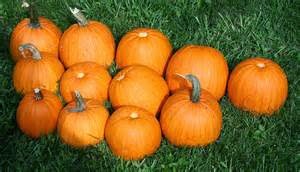Pumpkin is the name of a plant that refers to certain cultivars of squash, most commonly those of Cucurbita pepo, that are round, with smooth, slightly ribbed skin and deep yellow to orange coloration.
The thick shell contains the seeds and pulp. Some exceptionally large cultivars of squash with similar appearance have also been derived from Cucurbita maxima.
Specific cultivars of winter squash derived from other species, including C. argyrosperma, and C. moschata, are also sometimes called "pumpkin". In New Zealand and Australian English, the term "pumpkin" generally refers to the broader category called winter squash elsewhere.
Pumpkins, like other squash, are native to North America. Pumpkins are widely grown for commercial use, and are used both in food and recreation.
Pumpkin pie, for instance, is a traditional part of Thanksgiving meals in the United States, although commercially canned pumpkin puree and pumpkin pie fillings are usually made from different kinds of winter squash than the pumpkins frequently carved as jack o'lanterns for decoration around Halloween.
Pumpkins are very versatile in their uses for cooking. Most parts of the
pumpkin are edible, includinthe fleshy shell, the seeds, the leaves,
and even the flowers. In the United States and Canada, pumpkin is a
popular Halloween and Thanksgiving staple. Pumpkin purée is sometimes prepared and frozen for later use.
Often, it is made into pie, various kinds of which are a traditional staple of the Canadian and American Thanksgiving holidays. In Canada, Mexico, the United States, Europe and China, the seeds are often roasted and eaten as a snack.
Pumpkins that are still small and green may be eaten in the same way as squash or zucchini. In the Middle East, pumpkin is used for sweet dishes; a well-known sweet delicacy is called halawa yaqtin. In South Asian countries such as India, pumpkin is cooked with butter, sugar, and spices in a dish called kadu ka halwa. Pumpkin is used to make sambar in Udupi cuisine.
In Guangxi province, China, the leaves of the pumpkin plant are consumed as a cooked vegetable or in soups.
In Australia and New Zealand, pumpkin is often roasted in conjunction with other vegetables. In Japan, small pumpkins are served in savory dishes, including tempura.
In Myanmar, pumpkins are used in both cooking and desserts (candied). The seeds are a popular sunflower seed substitute. In Thailand, small pumpkins are steamed with custard inside and served as a dessert.
In Vietnam, pumpkins are commonly cooked in soups with pork or shrimp. In Italy, it can be used with cheeses as a savory stuffing for ravioli. Also, pumpkin can be used to flavor both alcoholic and nonalcoholic beverages.
In the southwestern United States and Mexico, pumpkin and squash flowers are a popular and widely available food item. They may be used to garnish dishes, and they may be dredged in a batter then fried in oil.
Pumpkin leaves are a popular vegetable in the Western and central regions of Kenya; they are called seveve, and are an ingredient of mukimo, respectively, whereas the pumpkin itself is usually boiled or steamed. The seeds are popular with children who roast them on a pan before eating them.
Commercially canned "pumpkin" puree and pumpkin pie fillings are often made with winter squashes other than the traditionally defined pumpkin, such as butternut squash.














0 comments:
Post a Comment